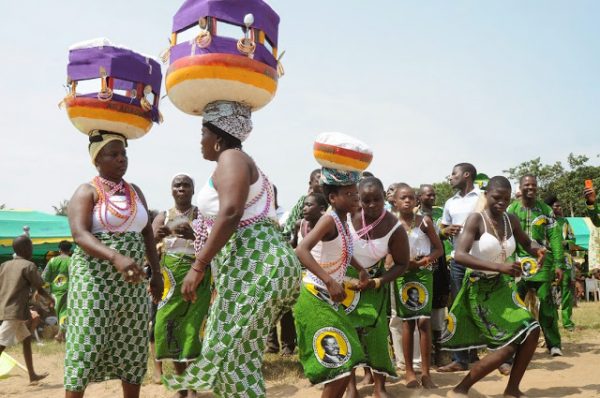Background
Traditionally, the Awori people are found in Ogun and Lagos States, Nigeria. Towns including Isheri, Ota, Igbesa, Agbara, Ilobi, Tigbo are all Awori settlements within present-day Ogun State (created 1976) in Nigeria. The settlement of the Awori clan is known to have preceded the establishment of Abeokuta as an Egba kingdom in 1832, as Isheri, the foremost Awori town within present day Ogun State was settled in the 15th century.
An anthropologist, W.G. Wormalin in his Intelligence Report on the Badagry district of the colony (1935) gives a graphic description of the early Awori he encountered when he writes that: “They speak a slurred dialect of the Yoruba language. They mostly engage in farming and fishing.”
Read more about Discover Nigeria
Origin story
The story is that Olofin (or Ogunfunminire, founder of the Awori) and his followers left the palace of King Oduduwa (ancestor of the Yoruba people) in Ile-Ife and migrated southward along a river. Oduduwa had given Olofin a mud plate and instructed him to place it on the water and follow it until it sank into the river.
Several days after leaving Ile-Ife, the plate suddenly stopped near Olokemeji near present-day Abeokuta. After seventeen days, it began moving again, only to stop at Oke-Ata for another seventeen days. At the end of seventeen days, the plate began moving again, only to stop again on the southern outskirts of present-day Abeokuta, where it stayed for another seventeen days. At this location, some of Olofin’s followers decided to remain, led by a man named Osho Aro-bi-ologbo-egan. The plate continued downriver, stopping again at Isheri, where it remained for a much longer period of time. Olofin began instructing his followers to begin setting up a permanent settlement, but after 289 days (17 x 17) the plate began moving again. Olofin and a few followers followed the plate, while the rest of the group stayed behind. After two days the plate stopped briefly at Iddo in Lagos. At Idumota in central Lagos, it whirled around in the water and sank to the bottom. When Olofin returned to his group at Iddo, they are said to have asked him where the plate was. He answered “Awo Ti Ri” meaning “The plate has sunk”. This is how the name Awori is said to have come into being.
In accordance with Yoruba custom, they brought their crown along with them from Ile Ife. Osolo, one of the sons of Prince Olofin, settled at the Osi quarters as his father and his brother journeyed further south from the place where the plate sank at Idumota. The first crowned Oba (king) or Olota of Ota at Ota, Ogun was Oba Akinsewa Ogbolu in 1621, he was the son of Osolo.
Sign up to the Connect Nigeria daily newsletter
Religion
Traditional beliefs and practice exist side-by-side Islam and Christianity. Some of the Awori combined Islam or Christianity with their traditional beliefs and practices. Islam was introduced to different parts of Aworiland before the twentieth century by Muslim clerics from the hinterland, while the diffusion of Christianity followed missionary activities in the region of Badagry from the 1840s. The use of Ifa oracle in the determination of certain issues and events such as date of festival, coronation ceremony, causes of state calamity is in practice among traditional believers. In addition, the institutions of priesthood and palace society for which the Yoruba of the interior are famous featured prominently between them. For instance, the possession of Ade crown and recognition of Oba, which is the highest conception of political authority among the Yoruba, is what every tradition leader, especially those from royal lineages in Aworiland aspire to.
Economy
Due to the nature of the geographical environment, fishing, rather than farming which is traditionally with the Yoruba, is the major traditional preoccupation of the seaside. Awori are also great farmers. In some regions, fishing is combined with mat and basket production and palm oil production. The climatic variation north of the coast offers an opportunity for the cultivation of a variety of crops. Cassava is probably the most widely cultivated as it could be planted and harvested throughout the year. In addition, it is a source of Garri, which now constitute a major staple food. Cassava is also processed for the production of starch and a locally produced starchy food known as Fufu and other confectionaries. Maize, Yams, Cocoyams and Oil Palm are also popular crops produced in the region. The food crops are supplemented by vegetables as well as animals such as goats, sheep and rabbits; birds like quail, cock, hen and goose, edible insects such as termites as well as alligators, which are prepared as a delicacy known as ‘Ònì’ among the Aworis of Lagos State.
Traditional Festival
Oro and Oree, Egungun, Elegba, igumuko,Opa, Osugbo and Gelede festivals among the traditional Awori communities are celebrated as people celebrate modern Sallah and Christmas with indigenes trooping back home from far and near when dates are fixed.
Sources:
Jeremy Seymour Eades (1980). The Yoruba Today. Cambridge University Press Archive. p. 16. Ruhollah Ajibola Salako (1999). Ota: The Biography of the Foremost Awori Town. Penink & Co. pp. 13–14.
Wikipedia
Featured Image Source: Trip Down Memory Lane
Got a suggestion? Contact us: editor at connectnigeria dot com


